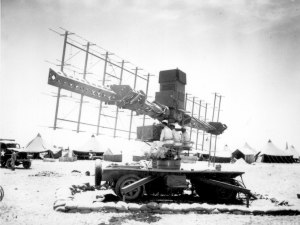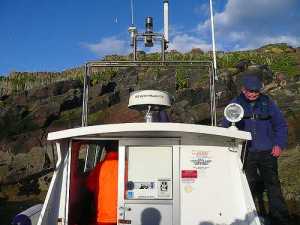Radar equipment is an important part of the modern world of technology which however, does not receive enough attention from the maritime sphere. This lack of attention possibly, will lead to more collisions and other navigation disasters aboard vessels where the barge we surveyed, after reading the survey report it appears that the radar placement was one of the reasons; hinting towards the possible lack of knowledge about the technical aspects and the less arbitrary purposes of radars.
Firstly, a radar is an object-detection system working on radio waves where the important variables obtained are range, altitude, direction and speed of objects such as aircraft, road vehicles, weather patterns and vessels. Radars are commonly placed as rotating dishes or antenna that emits pulses of radio or micro waves that travel and bounce off solid surfaces; to be reflected back to the dish.
Aboard a vessel, a radar system will produce information on bearings and ranges to give positions of sea-borne objects in closest proximity. Marine radars also fix a vessel’s position at sea when in vicinity of shore or other fixed objects. Radars work on a principle of radio transmission emitting radio waves in pre-determined direction; reflected off the object and transmitted back to the source. Radar signals are also reflected by materials able to conduct electricity as well as seawater. The objects themselves are detected by a weak absorption of radio waves by the medium through which it passes along with the radar relying on its own transmission instead of sun, moon light or electromagnetic waves emitted by detected objects.
As established above, radar equipment works on a principle of reflection and travelling through one material to meet another and occasionally scatter from boundaries between materials; meaning that solid objects in air and vacuum tend to scatter radar waves. Waves scatter in ways that depend on wavelength of outgoing waves and the shape of the object where the shorter wavelength than the size of the target it will bounce off like a ray of light from a mirror and therefore be detected. However, if wavelength is longer than the target size; detection will suffer due to poor reflection.
Longer wavelengths, therefore larger than their targets were prominent on earlier radar installations meaning that detection was inaccurate. This is also known as low-frequency radar where detection relies on resonances for detection but not identification of targets; known as Rayleigh scattering, an effect that creates blue sky and red sunsets where length scales are comparable therefore produce resonances.

Early radars used very long wavelengths, receiving vague signals.
Modern radar systems employ shorter wavelengths therefore can detect and image smaller objects. Short wavelengths reflect from curves and corners where most reflected targets have 90 degree angles between reflective surfaces. To enhance the capabilities of modern radar systems a corner reflector is placed on boats and buoys along with other seaborne structures; consisting of 3 perpendicular, flat surfaces which reflects waves directly towards the source.
A corner reflector works by reflecting an incoming radar wave 3x times (once by each surface) resulting in reversal of direction. The corner reflector’s basis is a rectangular coordinate system; travelling to the first face and reflected across the system, leaving the reflector with all 3 components of direction. Since the waves are electromagnetic it is worth discussing polarisation since the electric field is perpendicular to the direction of propagation therefore making the direction of the field is polarisation of the wave.
When transmitted, the radar signal’s polarisation is controlled for various results where an example of this is circular polarisation which can be used to minimise interference caused by weather effects. Linear polarisation, whereas returns indicate metal surfaces and random polarisation meaning fractal surfaces.
Radars have evolved from World War 2 from long wavelengths which depends purely on resonance to obtain most of its detection where such radars will not be beneficial in the maritime sphere. However, more modern marine radars have shorter wavelengths therefore the detection itself is enhanced where even the smallest objects appear along with the abundance of corner reflectors present on all seaborne objects.
Radars, like other parts of technology in relatively extreme conditions have their share of malfunctions which appear during its operation. A low-wavelength radar therefore, can produce more interference by its operation where even the smallest objects are detected thus shifting attention from real danger and producing clutter. The phenomenon of clutter comes from unwanted echoes in electronics which are typically, returned from ground and the sea itself along with the living organisms living on it.
Leading back to our recent survey where radar was an issue where it lost track of the movement at sea; radars have more issues that related to signal as well as distance of transmitters. Firstly, the radar beam itself follows a linear path in vacuum but following a somewhat curved pattern in atmosphere due to variation in the refractive index. (ways of wave propagation/movement through a medium) Maximum range of a conventional radar beam is limited by an array of factors such as; line of sight, maximum non-ambiguous range and radar sensitivity. All factors relate to range.
Relating the known radar issues to our surveyed barge a hypothesis can be drawn that relates to the refractive index as well as distance. As mentioned before, the onboard radar equipment’s placement created obstacles for the wave where the refractive index is challenged and therefore hinders detection of incoming objects even closer to the vessel’s proximity. Another possible aspect is the type of vessel that the radar is on, especially for short wavelengths where a barge would produce even more clutter with its load as the radar equipment works.
Finally, radar equipment is important aboard any vessel however it still comes with its own issues where the fate of the marine operation is placed on the line. Along with this, the type of vessel also interacts with the use of the radar equipment as barges have more interference especially when loaded.



